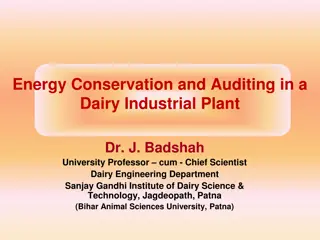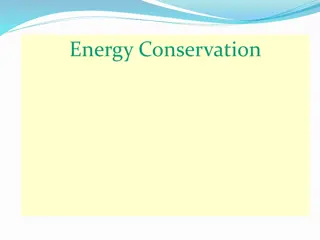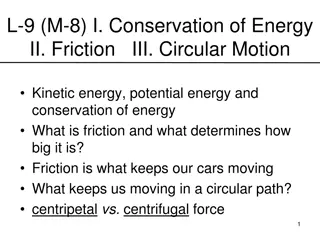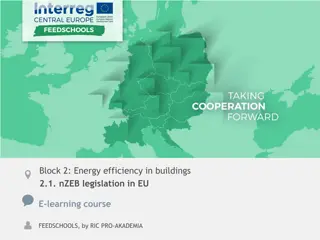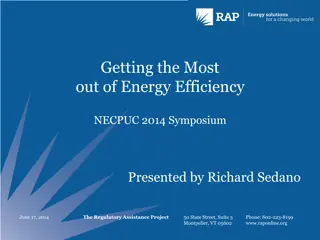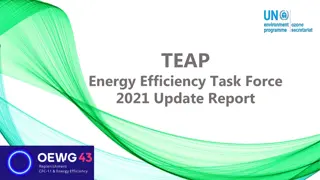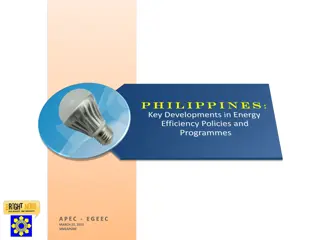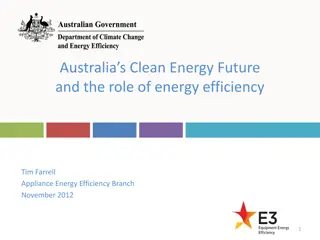Understanding Energy Efficiency and Conservation Fundamentals
This unit introduces basic terms related to energy, efficiency, and conservation, covering topics such as Efficiency and Conservation Energy, First and Second Law of Thermodynamics, and various heat transfer mechanisms. It emphasizes responsible energy use, focusing on efficiency, conservation, and the benefits of sustainable practices. By understanding efficiency and conservation, individuals can reduce energy consumption, increase comfort in their homes, and contribute to environmental preservation.
Download Presentation

Please find below an Image/Link to download the presentation.
The content on the website is provided AS IS for your information and personal use only. It may not be sold, licensed, or shared on other websites without obtaining consent from the author. Download presentation by click this link. If you encounter any issues during the download, it is possible that the publisher has removed the file from their server.
E N D
Presentation Transcript
Fundamentals of Energy HEAT TRANSFER AND EFFICIENCY Except where otherwise noted these materials are licensed Creative Commons Attribution 4.0 (CC BY)
The objective of this unit is to present the student with some basic terms relating to energy, efficiency, and conservation. Upon completion, the student will have an understanding of the following: Efficiency and Conservation Energy: Potential and Kinetic First and Second Law of Thermodynamics Temperature, Latent and Sensible Heat Conduction, Convection, and Radiation Objectives Fundamentals of Energy
Responsible energy use is future dependent on a couple of different premises. Energy Efficiency: Focuses on maximizing any economic benefits by proper energy management. Efficiency results in savings Example: An Energy Star rating on a piece of equipment Energy Conservation: This is the focus on Renewable Energies with the emphasis on reducing the use of non-renewable sources. Topic of conversation for many years Americans are using energy at an unsustainable rate. Requires an attitude change by users Fundamentals of Energy Fundamentals of Energy
Efficiency of Use: An efficient home will provide more comfort and a maximum value of energy use. Energy Security: Generating less waste will allow an individual to become less dependent on energy and less vulnerable to higher prices. Preservation of the Environment: Wasting fewer resources will lead to less damage to the environment. Benefits of Efficiency & Conservation Sustainability: By generating less waste and shifting toward renewables, we will preserve fossil fuels for future generations, allowing for more diversity. Fundamentals of Energy
To understand the use of renewable, a person needs to understand efficiency and conservation, in other words energy education. Households next to each other can require very different uses. Many different variables affect efficiency. To understand energy in the home, a homeowner must: Understand how heat flows Understand how comfort in the home occurs Understand the differences in lighting and appliances Understand health and safety of the home and occupants Understand an energy bill Use of Renewable Energy Fundamentals of Energy
Energy is a measurable quantity of heat, work, or light. Potential Energy: Energy that is stored like a cord of wood, a gallon of gasoline or a ton of coal, or geothermal heat source in the earth Kinetic Energy: Energy that is transitional like a flame or the energy extracted from the wind by a wind turbine Measured in different units Calorie: The amount of energy it takes to raise the temperature of 1 gram of water by 1 Celsius (C) Joule: One calorie is equal to 4.184 joules. British Thermal Unit (BTU): The amount of heat required to raise one pound of water 1 Fahrenheit (F). A kitchen match is about 1 BTU of heat. kWh: kilo watt-hour Energy Overview Fundamentals of Energy
The First Law of Thermodynamics: Energy can neither be created nor destroyed; it simply moves from one place to another and changes form. The potential energy from gasoline becomes the automobile s movement. The kinetic energy from the wind becomes electricity. The Second Law of Thermodynamics: Heat moves from higher temperature regions to lower temperature regions and never the reverse unless additional energy from an outside source is applied. The heated water or air from a home s heating system transfers heat to the air for comfort. The heated water from a solar thermal or geothermal heat source heats domestic water. Laws of Thermodynamics Fundamentals of Energy
Describes how hot or cold something is It is a measure of how fast molecules are moving or vibrating in a substance. Molecules in a solid are stationary but vibrate faster as heat is added. Heat flows because of a temperature difference between two points. Different geographic regions are characterized by the amount of heating and cooling they need. Heating Degree Days (HDD) is a measure of how cold a location is over a period of time relative to a base temperature, most commonly specified as 65 F. Cooling Degree Days (CDD) is a measure of how warm a location is over a period of time relative to a base temperature, most commonly specified as 65 F. Temperature Fundamentals of Energy
The relationship between waters temperature and heat content is predictable. This will allow us to calculate need or BTU s. Heat will always seek an equilibrium. Enthalpy: Heat content of substance The temperature of a given weight of material tells us how much energy that material contains. Understanding Types of Heat Sensible Heat Heat that can be felt Example: The temperature of a substance goes from 40 F to 45 F. Latent Heat Hidden heat or a change of state Example: Ice at 32 F will become a water ice mixture and remain at 32 F until all the ice is melted. Fundamentals of Energy
Heat travels from a high temperature to a lower temperature in three ways: Radiation Conduction Convection Understanding how heat travels Heat flow in a line of sight between bodies Heat flow in solids Heat flow in fluids Fundamentals of Energy
Conduction Heat conducted through solid objects touching one another. Metal and glass are good conductors. Wood and plastics are poor conductors. House insulation is a poor conductor. Example of Conduction: Picking up a hot frying pan will conduct heat in one s hand. Conduction and understanding the R-value R-value A measurement of conduction in reference to a building material s resistance to heat flow R-values are calculated for a given thickness of material; in a wall, the R-values will add up. Measured in BTU s per hour per degree Fahrenheit Fundamentals of Energy
Convection Heat transferred by a moving fluid like air or water Convection occurs when a portion of a fluid moves because of temperature and density differences. Density: Measures how many pounds a cubic foot of a fluid weighs Warmer fluid with lower density will tend to rise while denser cooler fluid falls. Natural Convection Example: With a radiator in one s house, the air from the room passes over the surface and heats the air in the room. Forced Convection Example: The furnace in one s house uses a fan to blow air across the heating portion of the furnace, transferring the heat to the air. Convection Fundamentals of Energy
Radiation Moves through space from one object to another As dictated by the second law of thermodynamics, heat flow will move from the higher temperature object to the lower temperature object. Objects within the line of sight of each other exchange heat radiation. Two important types of thermal radiation in regards to heat transfer Solar Energy Infrared Radiation Nuclear Regulatory Commission from US [CC BY 2.0]. Retrieved from https://commons.wikimedia.org/wiki/File:Heat_Radiation_Transparent _2_(26046216082).jpg Fundamentals of Energy
Upon completion of this unit, students should be able to Efficiency can be defined as the ratio of what we put into a system compared to what we get out. A latent change is a change of state and cannot be felt; however, a sensible change can be felt. Energy can be transformed, and it is never lost. Heat, a form of energy, can be considered a loss in a mechanical system. Everyone experiences heat transfer in some manner. For comfort, we transfer heat from where it is not wanted to a place where it is unobjectionable. Conclusions Degree days is a concept that will allow an individual the ability to predict heating or cooling needs, which we will be able to relate to efficiency. In order to preserve the earth, the focus needs to be on the conservation of resources. Energy education is the responsibility of everyone. This presentation was prepared by Northeast Iowa Community College under award EG-17-004 from the Iowa Energy Center. Any opinions, findings, and conclusions or recommendations expressed in this material are those of the author(s) and do not necessarily reflect the views of the Iowa Energy Center. Fundamentals of Energy




